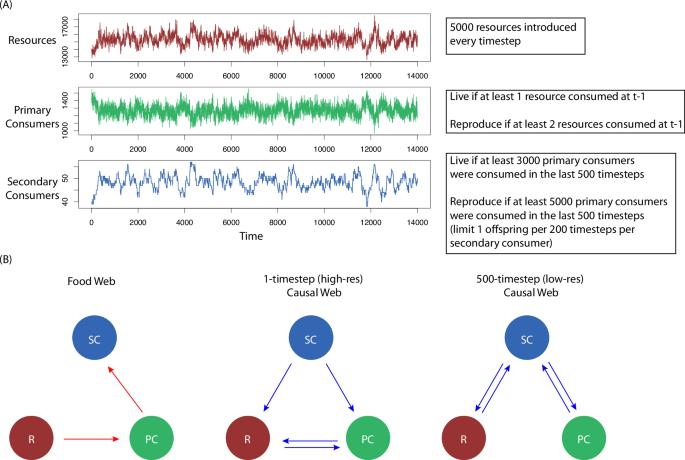The impact of data resolution on dynamic causal inference in multiscale ecological networks
IF 5.2
1区 生物学
Q1 BIOLOGY
引用次数: 0
Abstract
While it is commonly accepted that ecosystem dynamics are nonlinear, what is often not acknowledged is that nonlinearity implies scale-dependence. With the increasing availability of high-resolution ecological time series, there is a growing need to understand how scale and resolution in the data affect the construction and interpretation of causal networks—specifically, networks mapping how changes in one variable drive changes in others as part of a shared dynamic system (“dynamic causation”). We use Convergent Cross Mapping (CCM), a method specifically designed to measure dynamic causation, to study the effects of varying temporal and taxonomic/functional resolution in data when constructing ecological causal networks. As the system is viewed at different scales relationships will appear and disappear. The relationship between data resolution and interaction presence is not random: the temporal scale at which a relationship is uncovered identifies a biologically relevant scale that drives changes in population abundance. Further, causal relationships between taxonomic aggregates (low-resolution) are shown to be influenced by the number of interactions between their component species (high-resolution). Because no single level of resolution captures all the causal links in a system, a more complete understanding requires multiple levels when constructing causal networks. This paper examines how data resolution affects dynamic causal inference in ecological networks. Using Convergent Cross Mapping (CCM), we show that different temporal and taxonomic scales reveal varying causal links, important for ecosystem management.

数据分辨率对多尺度生态网络动态因果推理的影响
虽然人们普遍认为生态系统动力学是非线性的,但往往没有认识到非线性意味着规模依赖性。随着高分辨率生态时间序列的不断增加,人们越来越需要了解数据的规模和分辨率如何影响因果网络的构建和解释--具体来说,就是绘制一个变量的变化如何驱动其他变量变化的网络,作为共享动态系统的一部分("动态因果关系")。我们使用聚合交叉映射(CCM)--一种专门用于测量动态因果关系的方法--来研究构建生态因果网络时数据中不同的时间和分类学/功能分辨率的影响。在不同尺度下观察系统时,各种关系会出现或消失。数据分辨率与相互作用的存在之间的关系并不是随机的:发现关系的时间尺度确定了驱动种群丰度变化的生物相关尺度。此外,分类集合体(低分辨率)之间的因果关系受其组成物种(高分辨率)之间相互作用数量的影响。由于没有任何一种分辨率可以捕捉到系统中的所有因果联系,因此在构建因果网络时需要多个层次才能获得更全面的理解。本文探讨了数据分辨率如何影响生态网络中的动态因果推断。通过聚合交叉映射(CCM),我们发现不同的时间和分类尺度揭示了不同的因果联系,这对生态系统管理非常重要。
本文章由计算机程序翻译,如有差异,请以英文原文为准。
求助全文
约1分钟内获得全文
求助全文
来源期刊

Communications Biology
Medicine-Medicine (miscellaneous)
CiteScore
8.60
自引率
1.70%
发文量
1233
审稿时长
13 weeks
期刊介绍:
Communications Biology is an open access journal from Nature Research publishing high-quality research, reviews and commentary in all areas of the biological sciences. Research papers published by the journal represent significant advances bringing new biological insight to a specialized area of research.
 求助内容:
求助内容: 应助结果提醒方式:
应助结果提醒方式:


